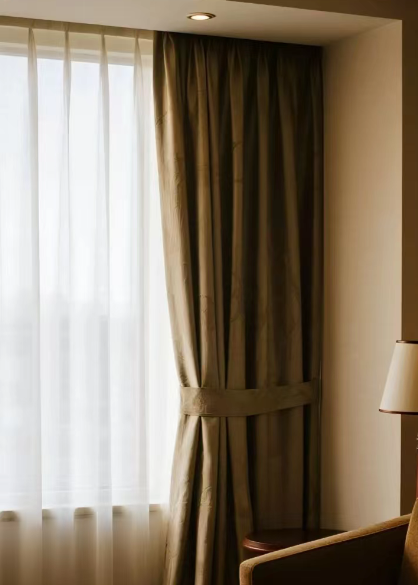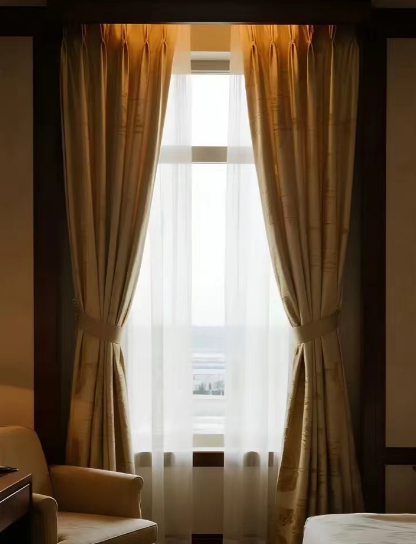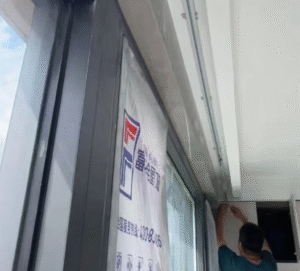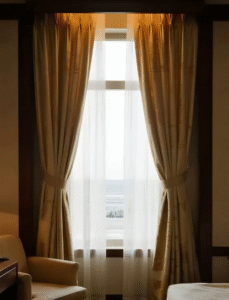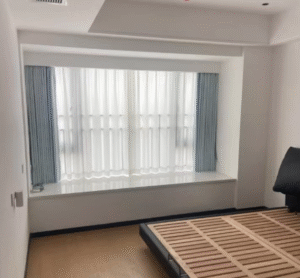As a purchasing manager for high-end projects, you've probably faced this nightmare. A designer signs off on a beautiful brushed bronze finish for a 500-room hotel. The first shipment for 100 rooms is perfect. But the next batch, produced a month later, arrives in a slightly different shade. Now, the hardware doesn't match across the property, your entire shipment is at risk of rejection, and the project timeline is in jeopardy. This isn't just about trends; it's about consistency.
The key trends making curtain tracks suitable for luxury hotels are finishes that combine sophisticated aesthetics with extreme durability. This includes matte blacks, brushed metallics like gold and bronze, and discreet matte whites. However, the most critical requirement isn't the finish itself, but the manufacturer's ability to guarantee absolute color and texture uniformity across thousands of meters and multiple production runs. For luxury hotels, this non-negotiable consistency is the true hallmark of a premium product.
This challenge of consistency is something I learned about firsthand, right on the factory floor. I saw how a tiny, one-degree change in an anodizing bath's temperature could alter the final color of an entire batch of aluminum tracks. A designer might fall in love with a 10cm sample, but our real job is to make sure the 5,000th meter of track they receive is identical to that first sample. It's a process of relentless control. This obsession with consistency is what separates a standard supplier from a partner fit for the luxury market. Let’s look at the trends, but always through this lens of absolute quality control.
Which material and finish innovations are luxury hotels prioritising?
Designers for luxury hotels are constantly pushing for unique, sophisticated interiors. Standard-issue white or silver aluminum curtain tracks just don't cut it anymore; they can make an expensive room feel cheap. You're tasked with sourcing hardware that reflects a premium aesthetic, but venturing into custom finishes feels risky. Will they scratch during installation? Will the color fade over time? And most importantly, can you get the exact same finish for all 700 windows in the project?
Luxury hotels are prioritizing material and finish innovations that offer both elegant looks and rock-solid durability. The focus is on advanced finishing processes like powder coating and anodizing, which provide a vast palette of textures and colors. Hotels are moving away from glossy surfaces toward sophisticated matte, brushed, and textured metallics. While high-grade aluminum remains the standard material, the real innovation is in the finish's ability to deliver custom colors with extreme durability and, crucially, perfect batch-to-batch consistency.
The demand for unique finishes has pushed us as manufacturers to become experts in surface chemistry. It's a fascinating field where we can now create finishes that are both beautiful and tough enough to handle the high-traffic hotel environment. It's not just about applying a color; it's about bonding it to the metal in a way that lasts.
Powder Coating: The Versatile Workhorse
Powder coating is a process where a dry, powder-like paint is applied to the track using an electrostatic charge and then cured with heat. This creates a finish that is much more durable than conventional liquid paint. It’s highly resistant to chipping, scratching, and fading. The big advantage is its versatility. We can match virtually any RAL color, allowing designers to perfectly coordinate the tracks with wall colors or other room elements. It's also available in different textures, from smooth matte to a sandy or hammered feel.
Anodizing: The Premium Standard
Anodizing is an electrochemical process that converts the surface of the aluminum into a durable, corrosion-resistant, anodic oxide finish. Unlike paint, it's integrated with the metal, so it can't chip or peel. It has exceptional abrasion resistance, making it ideal for hotel rooms where curtains are opened and closed frequently. Anodizing creates a beautiful translucent metallic sheen that is hard to replicate. The main challenge, and where true expertise shows, is maintaining exact color consistency across different production runs.
PVD Coating: The Ultimate in Luxury
Physical Vapor Deposition (PVD) is a high-tech process conducted in a vacuum. It deposits a thin film of metal onto the track, creating an incredibly hard and durable surface. This is the same technology used for luxury watches and high-end faucets. PVD can produce brilliant and consistent finishes like brushed gold, polished nickel, and graphite. It’s more expensive, but for top-tier luxury projects where performance and a flawless look are paramount, PVD is a growing choice.
| Finish Technique | Durability | Color Options | Consistency | Best For |
|---|---|---|---|---|
| Powder Coating | Very Good | Virtually unlimited | High | Custom colors, cost-effective durability. |
| Anodizing | Excellent | Limited to metallic tones | Difficult to master | High-traffic areas, metallic aesthetics. |
| PVD Coating | Exceptional | Premium metallics | Very High | Ultimate luxury, matching high-end fixtures. |
How do aesthetic considerations influence finish choices in upscale projects?
An interior designer spends months crafting the perfect vision for a luxury hotel suite. Every detail matters. They want the window hardware to either blend in seamlessly or stand out as a deliberate design element. A standard, bulky curtain track can completely disrupt this vision, looking like a clumsy afterthought. As the purchasing manager, you are tasked with finding a hardware solution that respects and enhances the designer's intent, avoiding a final look that feels disjointed or cheap.
Aesthetic considerations are a driving force in finish choices for upscale hospitality. The decision typically follows one of two paths: discretion or declaration. For a modern, minimalist aesthetic, designers choose recessed tracks finished in matte white or black to become invisible within the ceiling. This makes the curtain appear to float. Conversely, for a more traditional or industrial look, exposed tracks in statement finishes like matte black, brushed bronze, or satin nickel are used to complement other hardware like light fixtures and door handles, creating a cohesive design.
From my experience, the conversation with designers has shifted. Ten years ago, the only question was "white or silver?" Now, it's a detailed discussion about the design story. Is the hardware supposed to be a quiet background player or part of the main cast? Our job is to provide the options and the quality to execute their vision perfectly.
The Invisible Track: Recessed for a Seamless Look
The ultimate in modern luxury is often what you don't see. Recessed curtain tracks are designed to be mounted within a channel in the ceiling, completely hiding the hardware. The only thing visible is the track's narrow slot and the carriers. The finish for these tracks is almost always a simple matte white to match the ceiling, or matte black to create a "shadow line" effect. The aesthetic goal is to make the curtain look as if it is floating, emerging directly from the ceiling architecture. This creates an incredibly clean, uncluttered, and sophisticated look.
The Statement Track: A Cohesive Design Accent
In other design schemes, the curtain track is celebrated as a visible part of the decor. Here, the finish is critical. The trend is to match the track's finish to other metallic elements in the room, such as lighting, faucets, drawer pulls, and furniture legs. A popular choice is matte black for modern, industrial, or farmhouse-style interiors. For classic or art deco-inspired rooms, brushed bronze, satin brass, or antique gold add warmth and opulence. The success of this approach depends entirely on the quality and consistency of the finish.
Finish and Form: The Final Details
Beyond color, the shape of the track also plays a role. A sleek, minimalist profile works best for modern designs, while a more decorative or substantial track might be chosen for traditional spaces. Even the accessories, like the end caps and brackets for exposed tracks, must have the same high-quality finish. It's these small details that complete the luxury look and signal a high level of quality to discerning guests.
| Aesthetic Goal | Track Type | Common Finishes | Design Impact |
|---|---|---|---|
| Discretion | Recessed Track | Matte White, Matte Black | Clean, minimalist, modern. Curtain appears to "float." |
| Declaration | Exposed Track | Matte Black, Brushed Gold, Satin Nickel | Creates a cohesive accent, reinforces the design style. |
| Utilitarian | Standard Track | Anodized Silver, White | Basic functionality, less suited for luxury concepts. |
What role does durability play in finish selection for hotels?
A luxury hotel room might look beautiful on opening day, but it has to withstand the test of time and thousands of guests. You've sourced stunning matte black curtain tracks, but within six months, they are covered in scuffs from luggage and scratches from housekeeping's cleaning tools. The maintenance team tries to touch them up, but it only makes it worse. The once-premium finish now looks worn and cheap, detracting from the guest experience and creating a maintenance nightmare.
For luxury hotels, the durability and ease of maintenance of a finish are just as important as its appearance. A finish must be highly resistant to scratching, chipping, and fading from sunlight or harsh cleaning chemicals. The selection process prioritizes finishes like high-grade powder coating and anodizing, which are chemically bonded to the metal and can withstand daily wear and tear. A durable finish reduces long-term maintenance costs and ensures the hotel's interior looks fresh and luxurious for years, not just for the grand opening.
We can produce a track in any color a designer can dream of. But my first question is always: "How will it be cleaned?" I've seen beautiful finishes ruined by the wrong cleaning solvent. Part of our job is to produce a robust finish, and the other part is to educate our partners on how to care for it. A durable finish is a combination of good chemistry in our factory and good practice in the hotel.
The Abrasion Resistance Test
Hotel curtain tracks are subject to constant use. Guests pull them, housekeeping staff knocks them with vacuums, and luggage bumps against them. The finish needs to be tough. Anodized finishes are exceptionally good in this regard because the protective layer is part of the aluminum itself. High-quality powder coats are also very resilient. We perform abrasion tests in our labs to simulate years of use, ensuring our finishes can handle the demanding hotel environment.
Chemical and UV Resistance
Housekeeping departments use a wide range of cleaning products, some of which can be very harsh. A weak finish can be stained or stripped by the wrong chemical. Furthermore, tracks in rooms with a lot of natural light are exposed to constant UV radiation, which can cause colors to fade over time. A key part of our quality control is testing our finishes against common cleaning solvents and exposing them to intense UV light to guarantee color stability.
The Touch-Up Problem
One of the biggest maintenance challenges is repairing a scratch. With most high-performance finishes like anodizing or factory powder coating, a perfect on-site touch-up is nearly impossible. The touched-up spot will never look the same. Therefore, the primary strategy isn't repair, but prevention. The best solution is to choose a finish that is so durable that it resists damage in the first place. This is why investing in a superior finish upfront saves significant money and headaches in the long run.
| Durability Factor | Importance for Hotels | Best Performing Finishes |
|---|---|---|
| Abrasion Resistance | High (daily use, cleaning) | Anodizing, High-Quality Powder Coat, PVD |
| Chemical Resistance | High (harsh cleaning agents) | Anodizing, Chemical-Resistant Powder Coat |
| UV Resistance | High (sun-facing rooms) | Anodizing, Automotive-Grade Powder Coat |
| Repairability | Low (difficult to touch up) | Focus on upfront durability instead of repair. |
How can manufacturers align finish trends with sustainability?
The luxury hotel market is talking more and more about sustainability. Your clients, the hotel brands, are under pressure to make eco-friendly choices. This now extends to every detail, including curtain hardware. You're trying to source beautiful, trendy finishes, but you're also being asked tough questions about their environmental impact. Are there VOCs in the paint? Is the manufacturing process wasteful? Sourcing a product that is both stylish and genuinely sustainable is a new and difficult challenge.
Manufacturers can align finish trends with sustainability by investing in eco-friendly processes and materials. This means using powder coating, which contains no solvents and therefore releases almost no volatile organic compounds (VOCs). It also involves operating anodizing facilities with advanced water treatment and recycling systems. Sourcing high-recycled-content aluminum for the tracks themselves is another key step. By providing clear documentation and certifications for these practices, manufacturers can help their hotel clients achieve both their aesthetic goals and their sustainability targets.
Sustainability has been a core part of our evolution as a company. It started on the factory floor, looking at ways to reduce waste and use our resources more efficiently. Now, it's a key part of our conversations with clients. They want to know that the beautiful finish on our tracks isn't coming at a high cost to the environment. I'm proud that we can show them our processes and prove that luxury and responsibility can go hand in hand.
VOC-Free Finishes: The Power of Powder
One of the biggest environmental advantages in finishes comes from powder coating. Unlike traditional liquid paints, which use solvents that evaporate and release volatile organic compounds (VOCs) into the atmosphere, powder coating is a dry process. The unused powder can be collected and reused, leading to very little waste. For hotels looking to achieve green building certifications like LEED, specifying VOC-free finishes is a critical and easy win.
Responsible Anodizing
The anodizing process uses chemicals and significant amounts of water. A sustainable manufacturer addresses this head-on. This means investing in a closed-loop water treatment system that cleans and recycles the water used in the process, minimizing discharge into the environment. It also involves responsible management of the chemicals and waste products, adhering to strict environmental regulations.
Material Choice: The Power of Recycled Aluminum
The track itself is a huge part of the sustainability story. Aluminum is an ideal material because it can be recycled over and over again without losing its quality. We prioritize sourcing aluminum billets that have a high percentage of recycled content. This dramatically reduces the energy needed compared to producing virgin aluminum. By choosing a track made from recycled material, hotels can significantly lower the embodied carbon of their interiors.
| Sustainability Aspect | Unsustainable Practice | Sustainable Practice |
|---|---|---|
| Finishing Process | Liquid painting with solvents | VOC-free powder coating, PVD. |
| Water Usage | Discharging used process water | Closed-loop water treatment and recycling. |
| Material Sourcing | Virgin aluminum | High-recycled-content aluminum. |
| Waste Management | Landfilling unused paint/powder | Reclaiming and reusing oversized powder spray. |
Conclusion
In the world of luxury hotels, the trend in curtain track finishes is a story of balance. It's about finding the perfect harmony between a designer's aesthetic vision and the practical demands of a high-traffic environment. While matte blacks and brushed metallics are what catch the eye, the true hallmarks of a luxury-grade product are invisible. It is the exceptional durability that withstands years of use and the fanatical consistency that ensures the 500th room looks as perfect as the mockup. As manufacturers, our most important trend is our relentless commitment to process control, because we know that true luxury lies in flawless execution.
Relate
| Water Usage | Discharging used process water | Closed-loop water treatment and recycling.1 |
| Material Sourcing | Virgin aluminum | High-recycled-content aluminum.2 |
| Waste Management | Landfilling unused paint/powder | Reclaiming and reusing oversized powder spray. |



